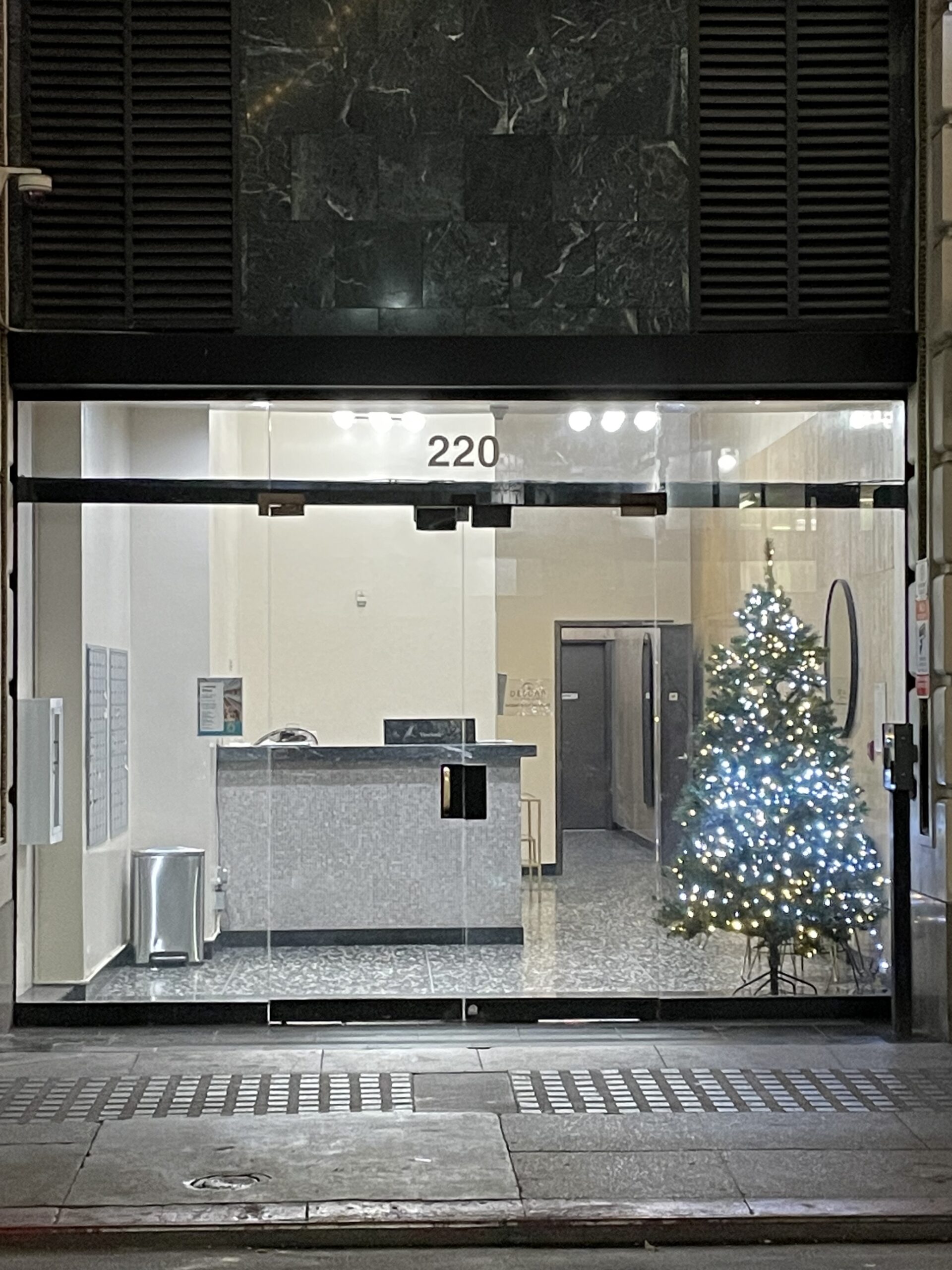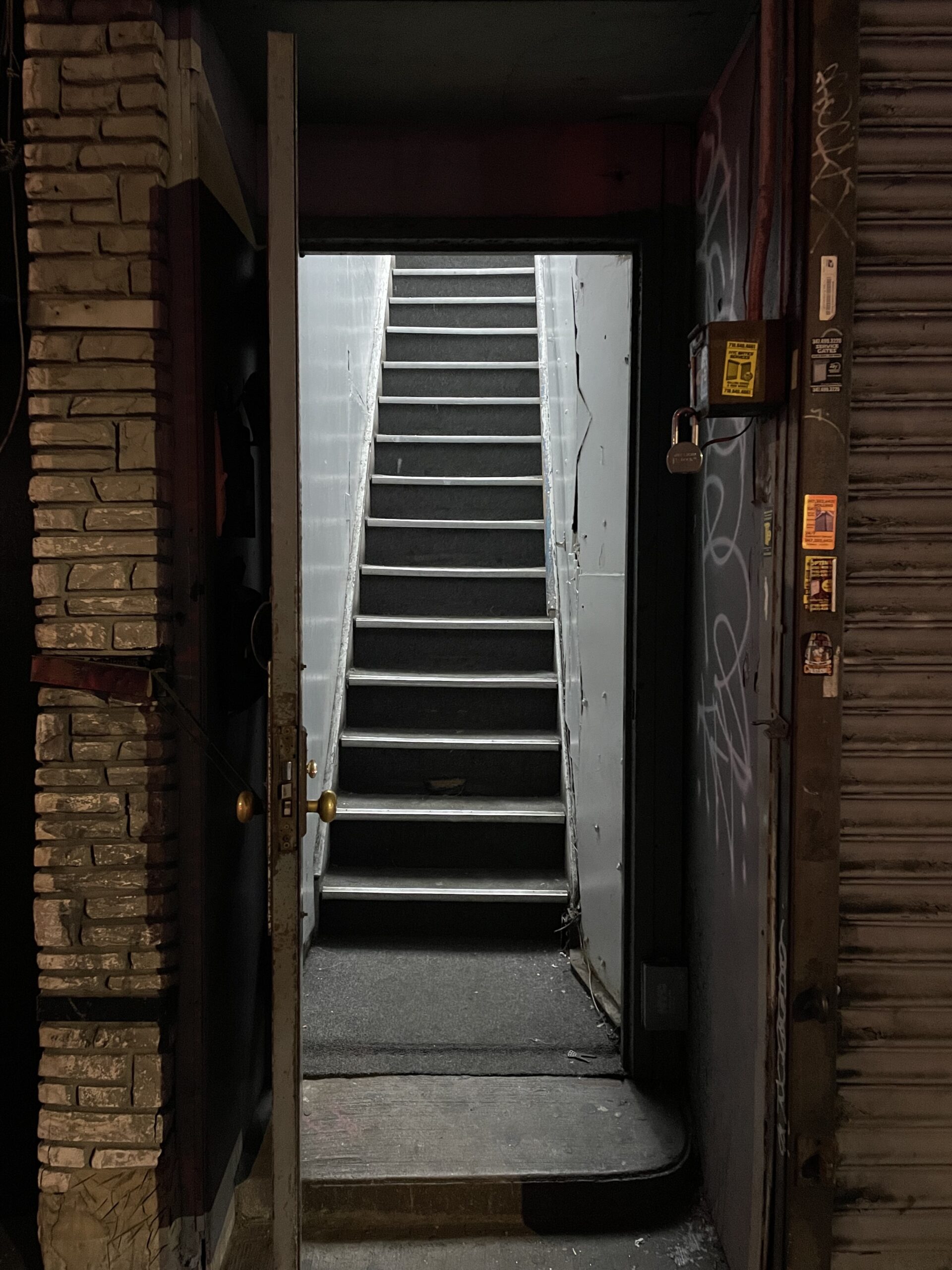WITHOUT CARE (1)
By:
October 31, 2025
First in a four-part series, by HILOBROW friend Colin Dickey, on “The Devoid,” a 21st century Gothic.

Horror movies, especially the cheaper ones, show reality in a state of crisis.
—Ken Hollings
I.
One night, a few months ago, I was walking alone down an unfamiliar street in my neighborhood. A friend had been over for drinks and, on the way home, had lost her keys — I was out, tracing her path to the subway station, hoping I’d spot them on the sidewalk. It was early October, a cool but not terribly cold night, and the walk took me down a series of streets I don’t normally see. At one point I passed by a salon that was closed for the evening, and something about the place struck me deeply. It was, I suppose, a mostly ordinary, undistinguished place, nothing noteworthy — save for the Christmas tree, sparsely decorated. The tree, out of season and without any overt sense of attention or care about it, was the only attempt at any kind of decoration in the salon. The sight of this place unnerved me in a strange way — the entire scene of the closed salon suddenly resonated in me, though nothing particularly was out of place or odd about any of it. But the Christmas tree, obviously put there on purpose and yet also suggesting a kind of abandonment (it was early October, after all), gave the entire place a sense of discomfort that I could not quite put my finger on.
I realized that I had felt this way around similar spaces, though I could not immediately put explain why, or what connected them. A few weeks later, I flew to Minneapolis to meet my girlfriend, who was working there for a few weeks. For her job, which involves staying in various cities for short periods, she’s usually given a room in some non-descript corporate hotel — a Courtyard, Homewood Suites, something like that — by the employer in town. This time, however, they gave her an apartment owned by the company; it was near to the college, in a building that was mostly student housing. I arrived minutes after she did, and she came down to the lobby to meet me, before taking me up to what I can only describe as a singularly upsetting room.
Again, it was hard to say, at first, what was wrong with it, even though, quite evidently, everything was wrong with it.
The bed was on a bare metal bedframe, with a single pillow on old but apparently clean sheets. Next to the bed was a folding table and a crooked rolling cart on which was propped the microwave. The matching couch and armchair were covered in a peach colored floral fabric, but each had been further haphazardly covered in an old blanket, as if to protect them from dogs or children. Aside from these two pieces and the bed, every other piece of furniture was foldable, rickety and on the verge of collapse. All of the furnishings, which included two framed, faded prints from long-gone art exhibitions, appeared to have come from Goodwill.
It became evident immediately that we could not stay there. It was easy enough to say that the room was shabby, but it was more than that — it appeared to have been put together by someone with only the vaguest notion of how humans live. Or, as though someone was attempting to approximate the first apartment of a college student — the random assemblage of second hand furniture, the absolute disregard of placement and quality, the utter disinterest of anything that might make a space feel homey or livable.
It called to mind pictures that friends had once posted on social media, of an AirBnB they had booked that turned out to be similarly — if more so—unnerving. In the bathroom, a slab of a mirror balanced on the tank of the green toilet, above which a Citibank towel was hung. The bedroom consisted of two twin beds, each inches off the ground on the barest of visible bedframe, at a ninety degree angle from each other against two walls, each with a gray fleece blanket and a single pillow. Another room had a floor of faux red brick, and a jacuzzi set off-center into the floor. A chair on the floor had been covered by a yellow and white beach towel, and there was a stack of pool noodles next to an American flag.
Once again, the apartment my friends had rented (apparently under false pretenses; the listing looked nothing like what they arrived to) seemed to have been furnished by someone with total disregard for how people inhabit a room. Aside from being threadbare and shabby, nothing was particularly amiss — but yet, the aggregate of details, each compounding on each other, had the net effect of rendering the space completely unnerving.
From these experiences, I began to try to both catalog and understand this particular feeling, something that felt on some level quite different from the usual way we talk about the uncanny or the eerie. Roland Barthes begins his late masterpiece Camera Lucida with a stubborn amazement that he felt upon looking at a certain photograph, an amazement which, he confesses, “no one seemed to share,” or even understand, leading him to comment “life consists of these little touches of solitude.” The book that follows is his attempt to explain this unexplainable feeling, to translate this small touch of solitude into a thing which, while never quite explaining his original amazement, nonetheless attempts to get to the heart of that feeling. So, too, I cannot exactly explain why that salon, with that Christmas tree, struck me so forcefully that night, but in the months since I’ve tried my best to fill in some of the gaps that might hint at that feeling.
I realized that while there was nothing overtly dark or upsetting about these spaces, they triggered a sensation in me that felt much closer to what the gothic originally triggered — far more than the usual tropes we associate with the gothic. Rather than abandoned ruins, these were places that were still somehow in use, and yet felt that some fundamental level of human presence and care had been withdrawn. Eventually, I settled on a name to describe such spaces — The Devoid — and set out to better understand this feeling.
II.
The gothic as a mood and an aesthetic arises out of a specific cultural moment: on the verge of the modern era, Horace Walpole coined the term to describe his The Castle of Otranto, in which he mixed elements of modern psychology and interiority with the supernatural. Walpole employed the term “gothic” primarily as a reference to “gothic architecture” — his novel was set in a gothic castle, and he wanted to evoke what that style had come to mean to eighteenth century audiences. Prevalent in Europe from about the 12th to the 16th centuries, the gothic was so-named by Italian art critic Giorgi Vasari, who considered it “barbarous” and invoked the Goths as a people known for tearing down old buildings and erecting their own. If Greek and Roman architecture had been associated with classical learning, symmetry, careful proportions, and idealized forms, then the Goths, who for Vasari were responsible for destroying all this, represented the antithesis to this.
The implication, in other words, was that what Vasari was terming “gothic architecture” was disordered, unthinking, random and lacking sense. We now associate it with an architectural style defined by pointed arched doorways, ribbed ceilings, and flying buttresses — a style both highly ornamented, and by the Enlightenment, out of style. Which also meant that most surviving examples of gothic architecture had been abandoned, fallen into disrepair, or otherwise taken on a gloomy, sullen atmosphere. Walpole’s literary genre was mean to have similar connotations: a new form of narrative that was wild, irregular, and strange, in addition to a being somehow forlorn, abandoned, and decrepit.
III.

More recently, and particularly in North America, that form of the gothic has been overtaken by a slightly more updated one, one based in Victorian aesthetics. When North American audiences think of the setting of gothic horror, we’re more likely to think of Victorian mansions and nineteenth century asylums than we are to think of abbeys and castles. Anglo settlers and their descendants did not have ruined churches or abbeys to draw from, and the architecture of the indigenous Americans does not translate into the white settlers’ imagination in quite the same form. The novels of Charles Brockden Brown notwithstanding, it’s really not until the 1840s, with works like Hawthorne’s The House of the Seven Gables, the “Custom House” intro of The Scarlet Letter, and Poe’s “The Fall of the House of Usher,” do we start to see North American fiction revolving around old, decrepit buildings — buildings that have stood “for generations” and that can read as gothic.
I did not make it to Sleep No More until early 2022, right after they had re-opened post-pandemic. An interactive theater that ran in Chelsea from 20011 until 2024, it exemplified the high point of the Victorian Gothic: unnerving children’s nurseries, looming apothecary’s shops, bare forests of skeletal trees. By that point, the design — while something I relished and enjoyed greatly — did not unnerve me in the least. Rather than feeling strange and unsettling, it felt instead comforting, a place to luxuriate in. I don’t know how I would have felt had I experienced it earlier in its run, but already by the time it opened the Victorian gothic had become quite familiar. In the wake of Tim Burton’s films and Mark Ryden’s art, the Victorian gothic has become quite ubiquitous, the kind of thing that decorates a teenager’s bedroom wall. It is the aesthetic of shopping mall boutiques, Halloween-themed amusement park rides, and other mass commodities.
What a Tim Burton film, Sleep No More, or a Mark Ryden painting all have in common is the clearly evident amount of work that goes into the aesthetic. It is a look that is heavily curated — one either appreciates it or not, but one cannot fail to note how studied and thoroughly designed these works are. In other words, the Victorian Gothic no longer accomplishes its original sense of the unnerving or the unsettling, not anymore. It is, if anything, comforting, and it is an aesthetic that, in order to achieve its desired affect, requires care — attention to design, attention to aesthetic.
WITHOUT CARE: I–III | IV–VI | VII–IX | X–XII.
MORE COLIN DICKEY at HILOBROW: IN THE MYSTERY CAVE (on Betty Boop’s Snow-White, Twin Peaks, and the erotic life of things) | KAIROS (Hermenautic Tarot series) | ANIMAL MAGNETISM (cross-posted series) | WIDESPREAD PANIC (Grok My Enthusiasm series) | ACÉPHALE (#Squadgoals series).
